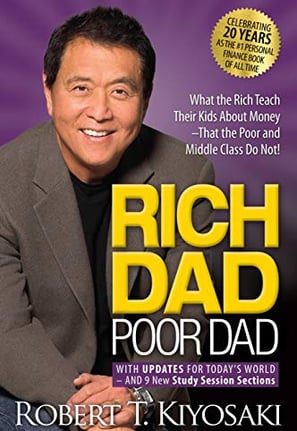Rich Dad Poor Dad


- Robert Kiyosaki


Here is an extensive and in-depth summary of the book "Rich Dad Poor Dad" authored by Robert Kiyosaki, offering a comprehensive overview of its key insights and concepts.
Introduction: Rich Dad, Poor Dad
In Chapter 1 of "Rich Dad Poor Dad," Robert Kiyosaki introduces two key figures in his life: his biological father (Poor Dad), a hardworking, educated individual who struggles financially, and the father of his best friend (Rich Dad), a high school dropout who becomes one of the wealthiest men in Hawaii through entrepreneurship. This chapter contrasts their differing perspectives on work and money, emphasizing the importance of financial literacy and independence.
Kiyosaki learns a crucial lesson from Rich Dad: the rich don't work for money; they make money work for them. This is demonstrated when Kiyosaki and his friend Mike start a comic book library, earning passive income. This early experience in entrepreneurship, guided by Rich Dad's teachings, shapes Kiyosaki's understanding of money and wealth, highlighting the power of financial intelligence and the potential of income-generating assets over traditional employment.


Lesson 1 : The Rich dont Work for Money
Chapter 2 of "Rich Dad Poor Dad," titled "Why Teach Financial Literacy?", delves into the importance of financial education as a key to wealth. Robert Kiyosaki, the author, contrasts the lessons learned from his two father figures: his own father (Poor Dad) and his best friend's father (Rich Dad). Poor Dad, despite his education and job security, struggled financially throughout his life, emphasizing the traditional path of earning and saving. On the other hand, Rich Dad, despite lacking formal education, accumulated wealth through financial intelligence, understanding the distinction between assets and liabilities, and making wise investment decisions.
Kiyosaki highlights that intelligence alone doesn't lead to financial success, as seen through a story of wealthy businessmen from the 1920s who eventually faced financial ruin. This demonstrates the necessity of adapting to economic changes and the importance of financial aptitude, which involves managing and investing money effectively. Rich Dad's approach to financial education was practical, using simple diagrams and real-life experiences to teach the boys about assets that generate income versus liabilities that drain resources.
The chapter discusses the middle-class mentality of working for money, getting trapped in debt, and mistaking liabilities for assets, a cycle Kiyosaki refers to as the "Rat Race." In contrast, the rich focus on buying income-generating assets first. Kiyosaki emphasizes the need for a shift in mindset from "I can't afford it" to "How can I afford it?", promoting a proactive approach to financial problem-solving and wealth creation.
Rich Dad's advice to start making money early, take risks, and learn from failures contrasts with the traditional academic path that prepares youth to be employees, often lacking in financial acumen. Kiyosaki observed that wealthy families educated their children early on using money to acquire assets, fostering a mindset focused on financial intelligence and long-term wealth building.

